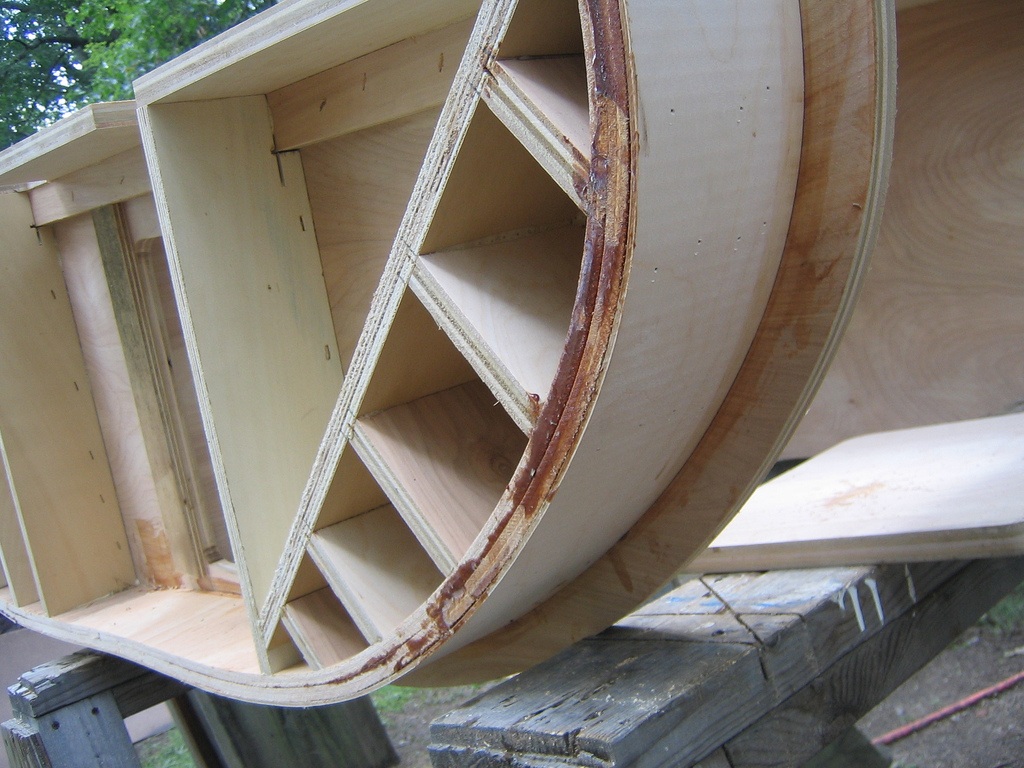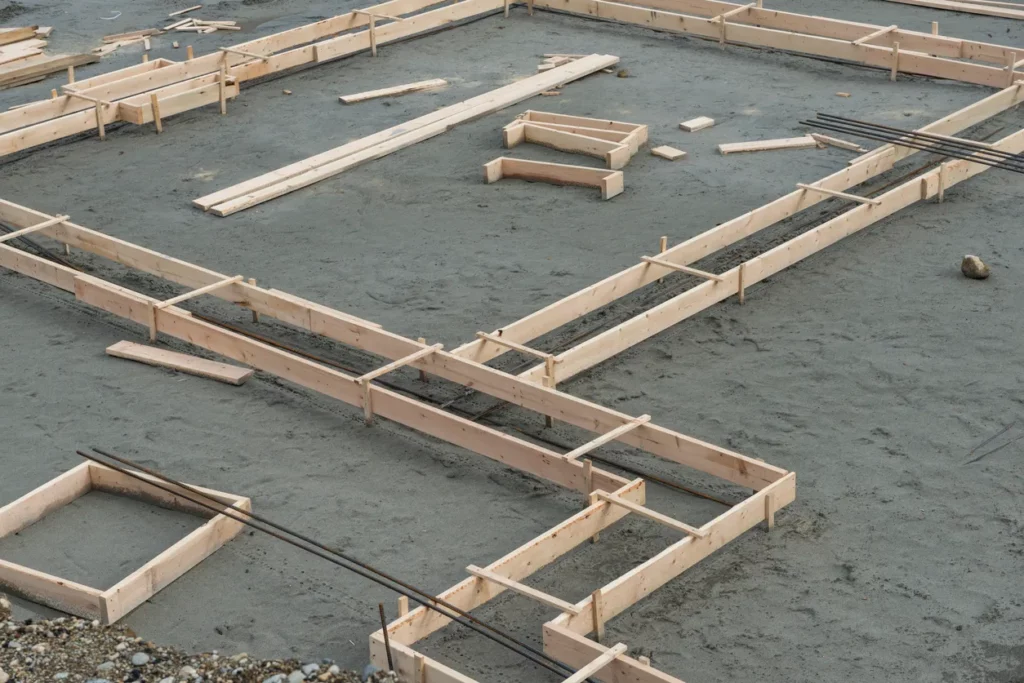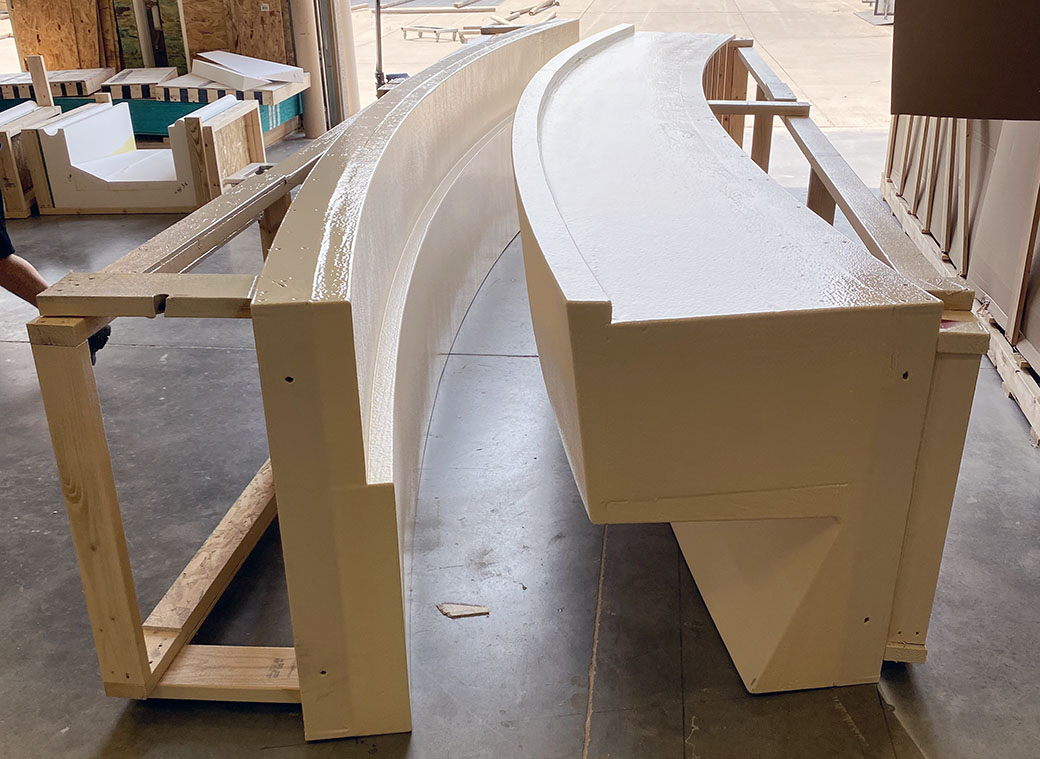Plywood curved concrete forms are an innovative solution in modern construction, especially for custom projects that require unique architectural features. These specialised formwork systems make it possible to create curved concrete structures by using the natural flexibility and strength of engineered plywood materials.
The use of plywood curved concrete forms in custom construction projects offers several benefits:
- Cost-Effective Solution: The relatively low material cost combined with potential reusability makes plywood forms an economical choice for builders
- Lightweight Properties: The reduced weight allows for easier handling and transportation on construction sites
- Design Versatility: The inherent flexibility of plywood enables the creation of complex curved shapes and unique architectural features
- Simple Modifications: On-site adjustments can be made quickly to accommodate design changes or overcome unexpected challenges
The adaptability of plywood curved concrete forms has opened up new possibilities in custom construction. It allows architects and builders to explore creative ideas while still considering practical aspects of building. These innovative forming systems are now essential tools for achieving both structural strength and visual appeal in contemporary architectural designs.

The Role of Formwork Materials in Construction Projects
Selecting appropriate formwork materials is a critical decision in construction projects, directly impacting the structural integrity and aesthetic outcome of concrete structures. The choice of formwork materials influences:
- Concrete Surface Quality
- Project Timeline
- Construction Costs
- Safety Standards
- Environmental Impact
Traditional Formwork Materials
Traditional formwork materials include steel, aluminium, timber, and engineered wood products. Each material has its own characteristics:
Find more on: Understanding LVL Timber Formwork Prices in Today’s Market
Steel Formwork
- High durability
- Suitable for repetitive use
- Significant initial investment
- Heavy transportation requirements
Aluminium Formwork
- Lightweight construction
- Corrosion-resistant properties
- Higher cost than wood-based options
- Limited flexibility for curved designs
Traditional Timber
- Natural material properties
- Limited reuse potential
- Susceptible to weather damage
- Variable quality standards
The Shift Towards Plywood Formwork
The construction industry’s shift towards plywood formwork is due to its balanced combination of strength, versatility, and cost-effectiveness. Plywood formwork offers:
- Precise concrete finish
- Adaptable design capabilities
- Reduced labour requirements
- Optimised material costs
- Enhanced sustainability practices
Choosing the Right Formwork Materials
The selection of formwork materials must align with specific project requirements, considering factors such as concrete pressure, temperature variations, and structural specifications. This careful consideration ensures successful concrete pouring operations and achieves desired construction outcomes. Find more about specifications on https://www.mit.edu/course/21/21.guide/specs.htm
Advantages of Using Plywood for Curved Concrete Forms
Plywood stands out as a superior choice for curved concrete forms, offering distinct advantages that make it an essential material in custom builds.

Cost-Effective Solution
- Lower material costs compared to steel or fibreglass alternatives
- Reduced labour expenses due to easier modification on-site
- Multiple reuse capabilities with proper maintenance
- Minimal waste during cutting and shaping processes
Lightweight Properties
- 60% lighter than traditional steel formwork
- Reduced equipment requirements for transportation
- Decreased worker fatigue during installation
- Faster assembly and disassembly times
- Enhanced site safety through easier manual handling
Unmatched Flexibility
The inherent flexibility of plywood enables the creation of complex architectural designs:
- Achieves smooth curves with radii as small as 50cm
- Adapts to both gentle and dramatic curved surfaces
- Creates precise geometric patterns
- Maintains dimensional stability under pressure
- Allows for on-site adjustments without specialised tools
Surface Quality Benefits
- Produces smooth concrete finishes
- Minimises surface defects and blemishes
- Creates consistent texture across curved surfaces
- Reduces the need for post-pour finishing work
The versatility of plywood formwork extends beyond basic construction applications. Custom builders can achieve architectural features such as curved walls, spiral staircases, and decorative elements with remarkable precision. The material’s natural properties allow for intricate detail work while maintaining structural integrity throughout the concrete pouring process.
The combination of cost-effectiveness, lightweight nature, and flexibility positions plywood as an ideal choice for curved concrete forms in modern construction projects. These advantages directly translate into improved project efficiency and enhanced design possibilities for custom builds. Click here to find more about efficiency.
Commonly Used Types of Formwork Plywood and Their Applications
Choosing the right type of formwork plywood is crucial for successful construction projects. By understanding the unique features of each type, you can select the best material to meet your specific project needs.
F14 vs F17 Plywood Grades
F14 and F17 plywood grades have different performance qualities:
F14 Plywood
- Suitable for light to medium-duty applications
- Cost-effective solution for residential projects
- Ideal for single-use formwork
- Lower density rating at 640 kg/m³
F17 Plywood
- Higher strength rating for heavy-duty construction
- Enhanced durability for multiple reuse cycles
- Superior moisture resistance
- Density rating of 680 kg/m³
HDO (High-Density Overlay) Plywood
HDO plywood represents a significant advancement in formwork technology:
- Resin-impregnated overlay creates an ultra-smooth surface
- Produces exceptional concrete finish quality
- Reduces the need for post-pour surface treatments
- Extended lifespan through multiple pour cycles
- Minimal concrete adhesion during stripping
LVL (Laminated Veneer Lumber) Formwork Applications
LVL formwork demonstrates superior performance in demanding construction scenarios:
Structural Benefits
- Enhanced load-bearing capacity
- Minimal deflection under pressure
- Consistent structural properties
- Reduced need for additional support systems
Practical Applications
- High-rise construction projects
- Complex architectural features
- Load-bearing walls
- Column formwork
- Bridge construction
The dimensional stability of LVL formwork makes it particularly valuable for projects requiring precise concrete placement and finish quality. The enhanced strength properties allow for larger pour volumes while maintaining form integrity, reducing the risk of blowouts or deformation during concrete placement.
Addressing Challenges Faced When Working with Formwork Plywood
Working with formwork plywood presents specific challenges during concrete pouring that require careful attention and strategic solutions. Here are the primary issues and their practical remedies:
1. Leakage and Bleeding
- Apply appropriate release agents before pouring
- Seal joints properly with compatible materials
- Install waterstops at critical junctions
- Use rubber gaskets around tie holes
2. Form Deflection
- Install adequate bracing at recommended intervals
- Use proper thickness of plywood for the pressure load
- Reinforce weak points with additional supports
- Monitor form movement during concrete placement
3. Surface Defects
- Clean forms thoroughly before each use
- Remove any debris or foreign materials
- Repair damaged areas with epoxy fillers
- Replace severely worn panels
4. Hydrostatic Pressure Management
- Control pour rates according to temperature conditions
- Monitor concrete consistency throughout the pour
- Maintain proper vibration techniques
- Adjust pour height based on form strength
5. Panel Degradation
- Store panels in dry, covered areas
- Apply protective sealants to edges
- Implement proper cleaning procedures after use
- Rotate panels to distribute wear evenly
These challenges can be effectively managed through proper planning, regular maintenance, and adherence to best practices in formwork installation and concrete placement techniques. The success of curved concrete forms depends significantly on addressing these issues proactively during the construction process.
Maximising Structural Integrity Through Proper Installation Techniques
Proper installation techniques are the foundation of successful LVL formwork implementation. The structural integrity of concrete structures relies heavily on precise installation methods and following established guidelines.
Essential Installation Requirements:
- Maintain consistent spacing between supports at 450mm-600mm intervals
- Secure all joints with appropriate fasteners and connectors
- Apply release agents evenly across contact surfaces
- Install bracing at 45-degree angles for optimal load distribution
The placement of reo bars within the formwork system requires careful attention to detail. A minimum concrete cover of 40mm must be maintained between the reo bars and formwork surface to prevent concrete deterioration and ensure structural longevity.
Critical Installation Steps:
- Level base preparation with compacted material
- Accurate alignment of vertical and horizontal members
- Proper tensioning of tie rods and walers
- Installation of chamfer strips at corners
The use of proper sealing techniques prevents concrete leakage and ensures clean, sharp edges. Silicone-based sealants applied at joints create watertight barriers, while foam gaskets installed between panels absorb vibration during concrete pouring.
Strict adherence to load-bearing capacities is crucial during installation. LVL formwork systems must be designed to withstand both dead loads and live loads, including concrete pressure, worker movement, and equipment weight during construction phases.
Sustainable Benefits and Cost Savings Offered by LVL Formwork Systems
LVL formwork systems are a significant advancement in sustainable construction practices, offering both environmental advantages and substantial cost reductions. These innovative systems demonstrate remarkable efficiency in resource utilisation through:
Environmental Impact Reduction
- Manufactured using fast-growing plantation timber
- Requires 40% less raw material compared to traditional formwork
- Produces minimal waste during manufacturing process
- Creates reduced carbon footprint through optimised transportation
Resource Optimisation
- Extended lifespan allowing 15-20 reuses per panel
- Resistant to warping and dimensional changes
- Maintains structural integrity throughout multiple applications
- Reduces construction waste by up to 30%
Economic Advantages
- Decreased labour costs through faster installation
- Reduced material replacement frequency
- Lower transportation expenses due to lighter weight
- Minimised maintenance requirements
The implementation of LVL formwork systems directly translates to measurable cost savings. Construction projects utilising these systems report a 25% reduction in formwork-related expenses compared to conventional methods. This cost efficiency stems from the material’s durability and reusability, eliminating the need for frequent replacements.
The enhanced strength-to-weight ratio of LVL panels enables larger spans between supports, reducing the quantity of required bracing materials. This structural efficiency translates to decreased material costs and accelerated construction timelines.
LVL formwork systems align with green building certifications and environmental standards, potentially qualifying projects for sustainability credits. The combination of resource efficiency, waste reduction, and extended service life positions LVL formwork as a cornerstone of modern sustainable construction practices.
Future Innovations Shaping The Landscape Of Concrete Construction
The construction industry is on the brink of significant changes brought about by technological advancements. Digital fabrication technologies, such as 3D printing and robotic assembly systems, are revolutionising the production of curved concrete forms. These innovations empower architects to explore new design possibilities while ensuring accuracy and minimising waste.
Emerging Technologies:
- AI-powered design optimisation tools
- Advanced composite formwork materials
- Smart sensors for real-time concrete monitoring
- Automated formwork assembly systems
The integration of parametric design software allows architects to experiment with complex geometries and organic shapes that were previously considered impractical. Current architectural trends indicate a move towards buildings with fluid forms and seamless curves, made achievable through these technological breakthroughs.
Research into self-healing concrete and carbon-negative formwork materials indicates a shift towards more sustainable construction methods. The development of nano-engineered concrete holds the promise of increased strength and durability, reducing the requirement for extensive formwork support systems.
These advancements present opportunities for architects and builders to bring ambitious designs to life while ensuring structural integrity and cost-effectiveness. The combination of traditional plywood formwork techniques with cutting-edge technology opens up new avenues for architectural expression.
Conclusion
Plywood curved concrete forms are an essential tool in modern custom construction, offering great value in many ways. Their combination of affordability, flexibility, and high-quality finish makes them a smart choice for builders.
The practical benefits are impressive:
- Cost Efficiency: Lower material costs and less need for labour
- Design Flexibility: Ability to create complex architectural features
- Structural Strength: Increased durability when installed correctly
- Eco-Friendly Practices: Sustainable construction methods
The creative possibilities offered by plywood curved concrete forms turn ordinary buildings into architectural masterpieces. They can shape concrete into smooth, flowing forms, creating unique structures that stand out and boost property value.
These advantages, along with ongoing advancements in formwork technology, make plywood curved concrete forms a wise investment for custom construction projects. The combination of practicality and artistic potential ensures that these forms will continue to be a leading choice in innovative building practices.

Leave a Reply